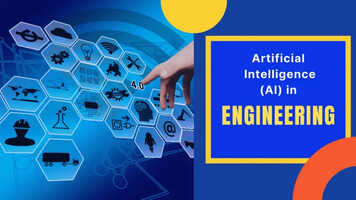The Role of Artificial Intelligence in Engineering Design
AI speeds up how engineers create things, improves workflows through smarter methods, also pushes new ideas forward.Artificial Intelligence (AI) is increasingly becoming a part of daily lives in all sorts of areas, also in how engineers draft and build things. Recently, it reshaped the way professionals solve complex challenges: making work faster and even better while sparking new thinking. With this technology continuously expanding, it will become a key tool to shape the designs of the future.
1. What is Artificial Intelligence in Engineering Design?
AI refers to the development of gadgets handling tasks that normally require human thinking. These systems, applied in design work, speed up the process by automating tasks and increasing results. Instead of going through manual steps, smart software corrects itself based on studying lots of data. Since AI learns from examples, they become better at guessing outcomes or finding patterns. This leads to fewer mistakes and quicker progress at work for new products or buildings.
2. AI in Conceptual Design
Early on, where engineers start creating things, AI jumps in to create many varied possibilities instead. The old-school methods usually rely on group ideas, rough drawings, as those take time and involve lots of testing. However, when AI is involved, the process gets easier as it scans stuff like material toughness or cost caps, yet keeps weighing performance needs at the same time. With all those details, it suggests solid options.
3. Optimisation and Simulation
One major application of AI in engineering is optimisation. It runs complicated smart math tricks to nail the best setup which can encourage lighter builds without losing toughness, or cheaper options that still work better.
AI simulation tools enable engineers to test designs on computers even before physical modeling is created. Anything from testing a bridge or airplane wings in a virtual storm or under extreme heat can be done using intelligent software.
4. AI in Automating Repetitive Tasks
Engineering design, in general, involves repetition of similar tasks: blueprinting, testing, recalculating. With AI, many such steps happen automatically without the intervention of human beings, saving time for an engineer to attend to more challenging problems.
Consider 3D models: rather than creating them from scratch, AI generates them directly from 2D drawings. Even better, if there is a change in the design, that automatically gets reflected, which means all the specifications remain updated without anybody touching them.
5. AI and Collaboration in Engineering Teams
In modern engineering tasks, working together plays a key role. With smart apps, teams stay in touch easier - info travels quickly since folks spot edits right away. With cloud-based tools, experts from different locations link up effortlessly during complex projects.
A computer works through big piles of info way faster than people can. This really helps in areas like building machines. Since it checks facts in a flash, folks on the crew get news just when they need it.
6. The Future of AI in Engineering Design
The role of AI in engineering design is likely to further grow. Thanks to AI, especially when combined with machine learning and neural networks, a great leap forward could be created, something previously unimaginable for engineers. Utilizing AI may finally result in sharper, greener, cheaper, and, all in all, better value.
AI designing green buildings, or creating super-light materials, might disrupt industries such as aviation or car manufacturing. Besides this, it could be used for smarter infrastructure-say, roads healing themselves or traffic systems adapting in real-time, matching the speed with which cities grow.
Artificial Intelligence is changing engineering design at almost every turn: speeding things up, then cutting waste, yet at the same time, pushing the boundaries of innovation. Instead of manually sketching out their ideas, humans are now aided by machines capable of suggesting alternatives, adjusting efficiencies, and automating mundane tasks. To learners who will create the technology of tomorrow, understanding how AI works can provide a serious edge as they enter into this changing world.
Latest Articles

The Role of Artificial Intelligence in Engineering Design
UniList Desk
Nov 03 2025
Best Study Material for SSC CGL 2026 Preparation
UniList Desk
Nov 03 2025
Common Mistakes UPSC Aspirants Make During Preparation
UniList Desk
Nov 03 2025
Careers in Advanced Material Science for IIT Graduates
UniList Desk
Nov 03 2025
Top Rising MBA Specializations That You Can't Overlook
UniList Desk
Nov 03 2025
CUET vs JEE: Which is More Challenging in 2026
UniList Desk
Nov 03 2025
Top 10 NITs Colleges in India 2025
UniList Desk
Oct 31 2025
Common Mistakes to Avoid in JEE Main
UniList Desk
Oct 31 2025
UPSC 2026: The Smart Way to Crack the Civil Services Exam
UniList Desk
Oct 31 2025
How to Get Admission in a Central University a Low Score
UniList Desk
Oct 31 2025
Learn More, Grow Faster
Get Updates Straight to Your Inbox!